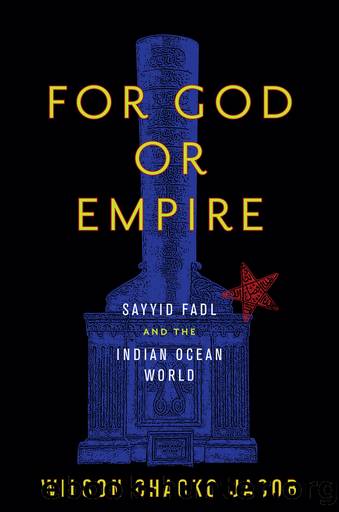For God or Empire by Jacob Wilson Chacko;

Author:Jacob, Wilson Chacko; [Jacob, Wilson Chacko]
Language: eng
Format: epub
Publisher: Stanford University Press
Published: 2019-08-14T16:00:00+00:00
The shrine of Sayyid Alawi in Mampuram, Kerala, India. It was erected and renovated multiple times after his death in 1844. Photo by author.
The latter is a big question and hence will be taken up only in the next chapter, Chapter 6. Here, the absent presence of a saintly friend’s life as time passes might be regarded as animating the seemingly wild methodology of this chapter, which juxtaposes a postmodern archive on YouTube and social media with traditional hagiography and modern colonial archives. First, we look at how today’s Wahhabism, particularly in its state-centered Saudi mode, views the world and the role of Sufism in it. Then we move to a Mappila, Sufi-aligned hagiographic view of the world and the Alawis in it. We conclude by considering the implications of colonial and postcolonial Mappila attempts to bring back the Alawi family along with their own efforts to return.
Purity, Life, and Islam’s Cyberspace
Over the long nineteenth century, “Wahhabi” became shorthand for any expression of Islam that at least superficially appeared as a rejection of “modernity,” usually meaning “Westernization.” A synonym in this reductive discourse, found also among Muslims, is “Salafi.” Much has already been written about the conceptual and political problems with both terms. From a historical perspective, it can safely be said that the eponymous founder of so-called Wahhabism, Muhammad Ibn Abd al-Wahhab, did not envision all the kinds of movements that would emerge under this umbrella.3 What was at the heart of Abd al-Wahhab’s message was purification; just like many before him and during his own time, he denounced accretions and innovations at the level of theology and sacred rituals. The meaning of the political alliance he forged with the House of Saud was and remains a major source of the conflicting interpretations of Wahhabism.
The Wahhabi opposition to Sufism is typically manifested in preaching against saints, shrines, and visitation to graves. As Engseng Ho has shown for Yemen and recent events have shown in Pakistan and elsewhere, the accompanying violent destruction of these holy sites is part and parcel of a larger political-theological discourse that intersects, though not always contradictorily, with neoliberal economic policies imposed by the US and international agencies.4 The propaganda originates in large part from the staunchly pro-US Gulf countries and has found its way from traditional print and mass media to new media and now to social media. Meanwhile, the same evolution has required the Saudis to step up their game. The propaganda may have increased in recent years as the struggle to define orthodoxy leans in an anti-Saudi direction, the ebbs and flows of which are arguably tied to US policy in the Middle East and the Islamic world. At a recent conference of leading Sunni ulama convened in Chechnya, not only were Saudi scholars seemingly not invited, but an initial definition of Sunni Islam, or who could be called “ahl al-sunna wa-l-jama‘a,” excluded the Salafi Wahhabi tradition—the predominant legal and theological schools in Saudi Arabia—while recognizing Sufism. Not coincidentally, one of the organizers of the meeting was Habib Ali al-Jifri, an Alawi and preacher with a significant media presence.
Download
This site does not store any files on its server. We only index and link to content provided by other sites. Please contact the content providers to delete copyright contents if any and email us, we'll remove relevant links or contents immediately.
| Military | Political |
| Presidents & Heads of State | Religious |
| Rich & Famous | Royalty |
| Social Activists |
Waking Up in Heaven: A True Story of Brokenness, Heaven, and Life Again by McVea Crystal & Tresniowski Alex(37000)
Empire of the Sikhs by Patwant Singh(22168)
We're Going to Need More Wine by Gabrielle Union(18067)
Hans Sturm: A Soldier's Odyssey on the Eastern Front by Gordon Williamson(16584)
Leonardo da Vinci by Walter Isaacson(11897)
The Radium Girls by Kate Moore(10903)
Educated by Tara Westover(7056)
Tools of Titans by Timothy Ferriss(6938)
How to Be a Bawse: A Guide to Conquering Life by Lilly Singh(6688)
The Last Black Unicorn by Tiffany Haddish(5066)
Permanent Record by Edward Snowden(4988)
The Rise and Fall of Senator Joe McCarthy by James Cross Giblin(4841)
Promise Me, Dad by Joe Biden(4441)
The Wind in My Hair by Masih Alinejad(4421)
The Crown by Robert Lacey(4100)
A Higher Loyalty: Truth, Lies, and Leadership by James Comey(4028)
The Iron Duke by The Iron Duke(3637)
Joan of Arc by Mary Gordon(3254)
How to be Champion: My Autobiography by Sarah Millican(3182)
